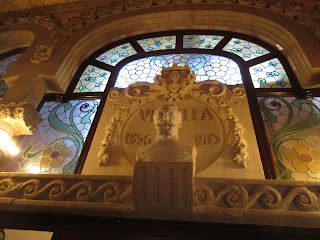Much to our surprise when researching the sights to see in Barcelona months in advance of our visit, the second-listed locale in all of Barcelona was the Palace of Catalan Music. The concert hall, finished in 1908, was built in just three years under the direction of Catalan architect Lluis Domench i Montaner, a protegee of Antonin Gaudi. A visit to the Palau as it's referred to, was only possible via a pretty pricey 55-minute guided tour reserved up to four months ahead.
The Palau was designed as a home for Barcelona's choir, the Orfeó Catalá which still perform at the venue today. As the Palau was a private palace owned by the choir and its sponsors, it therefore receives no government assistance. The magnificent foyer was built in 1925.
In front of the Palau, located on a narrow street close to Barcelona's Cathedral, was this intriguing statue by artist, sculptor and engraver Jaume Plensa. Carmela was a 4.5 meter high iron sculpture of a “classical Mediterranean beauty.” What made it so special was the figure seemed to change depending on the perspective and where I stood.
The Palau was conceived and designed as an enormous glass box crowned with a large central skylight. It has been listed as a UNESCO World Heritage Site since 1997. Montaner designed the building which was primarily funded by donations from the city’s bourgeoisie. The theater's patrons encouraged him to build a uniquely Catalan building to express their national pride. The architect hired local craftsmen and artisans who created the vivid ornamentation and sculpture which decorated the entire building.
While waiting for the tour to begin, the Palau's stunning cafe set the stage for what we were about to see.
The Palau was designed as a home for Barcelona's choir, the Orfeó Catalá which still perform at the venue today. As the Palau was a private palace owned by the choir and its sponsors, it therefore receives no government assistance. The magnificent foyer was built in 1925.
The floral theme was carried out throughout the entire Palau.
The Barcelona Floral Games, a poetry competition with an ancient tradition, were held at the Palau from 1914 until the outbreak of the Spanish Civil War in 1936. The queen presided over the event sitting at the throne in the center of the stage surrounded by her ladies in waiting and the authorities. The bronze throne was forged in 1908. Am I the only one that thinks the throne looks awfully uncomfortable?!
What a striking sight greeted us when we walked out onto the narrow balcony overlooking the street we'd just been on and saw the gorgeous columns. Each one had a different design.
The guide proudly stated that all the materials for the construction of the Palau were from Barcelona except for the organ which was designed by an architect. It had 3,525 pipes.
The immense hand crafted skylight, weighing 1,000 kilos and representing the sun, had to have been the most gorgeous and impressive stained glass I have ever seen. It was lit by natural light helped by lamps with flowers bending toward the sun.
The details in the music hall were all spectacular from the tiny rosettes, to the lovely chandeliers, to the striking marble sculptures. It was hard to know where to look as I was concerned I might miss something. It was a feast for the eyes,
Fortunately, there was no damage done to the Palau during the Civil War but it wasn’t for lack of trying, according to the guide! The office on the main street was destroyed and it had all the information on the number of workers, the costs, so all the background information and history was lost forever.
The pipe organ and acoustics were no doubt top notch, but it was the artwork that set it apart from any other.
The Greek muses on the stage could be seen from
the most expensive seats. The seats by the organ were for the students.
According to our guide, the names of the donors on the 2,146 seats showed the commitment by locals to having a world-class performing arts center.
When we looked closely, we could spot the names of famous musicians in the ceiling.
The Palau was outstanding. I could only imagine what the concert hall has seen and heard as the world's best composers and performers have played this venue. No doubt the best way to experience the Palau would be to attend an actual performance and enjoy the light, the music and the beautiful concert hall.
Next post: The eye-popping La Sagrada Familia by Gaudi.
Posted on November 25th, 2018, from Ronda, Andalucia, in Spain.







































Barcelona is on my bucket list and this post provides me with more reasons to keep it there ! Outstanding ! xo
ReplyDelete